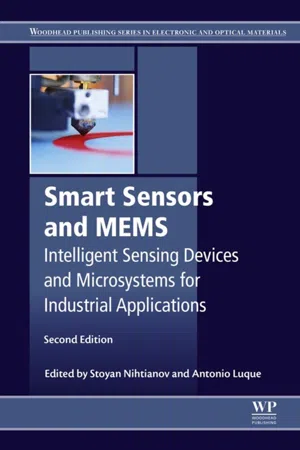
Smart Sensors and MEMS
Intelligent Sensing Devices and Microsystems for Industrial Applications
- 604 pages
- English
- ePUB (mobile friendly)
- Available on iOS & Android
Smart Sensors and MEMS
Intelligent Sensing Devices and Microsystems for Industrial Applications
About this book
Smart Sensors and MEMS: Intelligent Devices and Microsystems for Industrial Applications, Second Edition highlights new, important developments in the field, including the latest on magnetic sensors, temperature sensors and microreaction chambers. The book outlines the industrial applications for smart sensors, covering direct interface circuits for sensors, capacitive sensors for displacement measurement in the sub-nanometer range, integrated inductive displacement sensors for harsh industrial environments, advanced silicon radiation detectors in the vacuum ultraviolet (VUV) and extreme ultraviolet (EUV) spectral range, among other topics. New sections include discussions on magnetic and temperature sensors and the industrial applications of smart micro-electro-mechanical systems (MEMS).The book is an invaluable reference for academics, materials scientists and electrical engineers working in the microelectronics, sensors and micromechanics industry. In addition, engineers looking for industrial sensing, monitoring and automation solutions will find this a comprehensive source of information.- Contains new chapters that address key applications, such as magnetic sensors, microreaction chambers and temperature sensors- Provides an in-depth information on a wide array of industrial applications for smart sensors and smart MEMS- Presents the only book to discuss both smart sensors and MEMS for industrial applications
Frequently asked questions
- Essential is ideal for learners and professionals who enjoy exploring a wide range of subjects. Access the Essential Library with 800,000+ trusted titles and best-sellers across business, personal growth, and the humanities. Includes unlimited reading time and Standard Read Aloud voice.
- Complete: Perfect for advanced learners and researchers needing full, unrestricted access. Unlock 1.4M+ books across hundreds of subjects, including academic and specialized titles. The Complete Plan also includes advanced features like Premium Read Aloud and Research Assistant.
Please note we cannot support devices running on iOS 13 and Android 7 or earlier. Learn more about using the app.
Information
What makes sensor devices and microsystems “intelligent” or “smart”?
Abstract
Keywords
1.1. Introduction
- • city traffic by analysis of data coming from cars, which concern their function and movement direction;
- • operation of manufacturing equipment for efficient output of small series of various products;
- • power generation by optimizing power loads of electrical, nuclear, and hydraulic plants, etc.
- • the number of measuring channels in one CPS may be thousands or many hundreds of thousands of units;
- • measurement channels can include microelectromechanical systems (MEMS) and sensors measuring various quantities, either electrical or nonelectrical; as a rule these channels being spaced far from each other;
- • in the process of CPSs operation, measurands and the number of channels can sufficiently change;
- • in CPSs the “cloud technologies” can be applied;
- • in many cases, measurement information has to be transmitted over great distances;
- • as a rule, an access for metrological maintenance of MEMS and sensors that are components of the CPSs is complicated, and so on.
1.2. Interpretation of terms re...
Table of contents
- Cover image
- Title page
- Table of Contents
- Related titles
- Copyright
- List of Contributors
- 1. What makes sensor devices and microsystems “intelligent” or “smart”?
- 2. Interfacing sensors to microcontrollers: a direct approach
- 3. Smart temperature sensors and temperature sensor systems
- 4. Capacitive sensors for displacement measurement in the subnanometer range
- 5. Integrated inductive displacement sensors for harsh industrial environments
- 6. Magnetic sensors and industrial sensing applications
- 7. Advanced silicon radiation detectors in the vacuum ultraviolet and the extreme ultraviolet spectral range
- 8. Advanced interfaces for resistive sensors
- 9. Reconfigurable ultrasonic smart sensor platform for nondestructive evaluation and imaging applications
- 10. Advanced Optical Incremental Sensors: Encoders and Interferometers
- 11. Microfabrication technologies used for creating smart devices for industrial applications
- 12. Microactuators: Design and Technology
- 13. Microreaction chambers
- 14. Dynamic behavior of smart microelectromechanical systems in industrial applications
- 15. Microelectromechanical systems integrating motion and displacement sensors
- 16. Microelectromechanical systems print heads for industrial printing
- 17. Photovoltaic and fuel cells in power microelectromechanical systems for smart energy management
- 18. RF-MEMS for smart communication systems and future 5G applications
- 19. Smart acoustic sensor array system for real-time sound processing applications
- Index